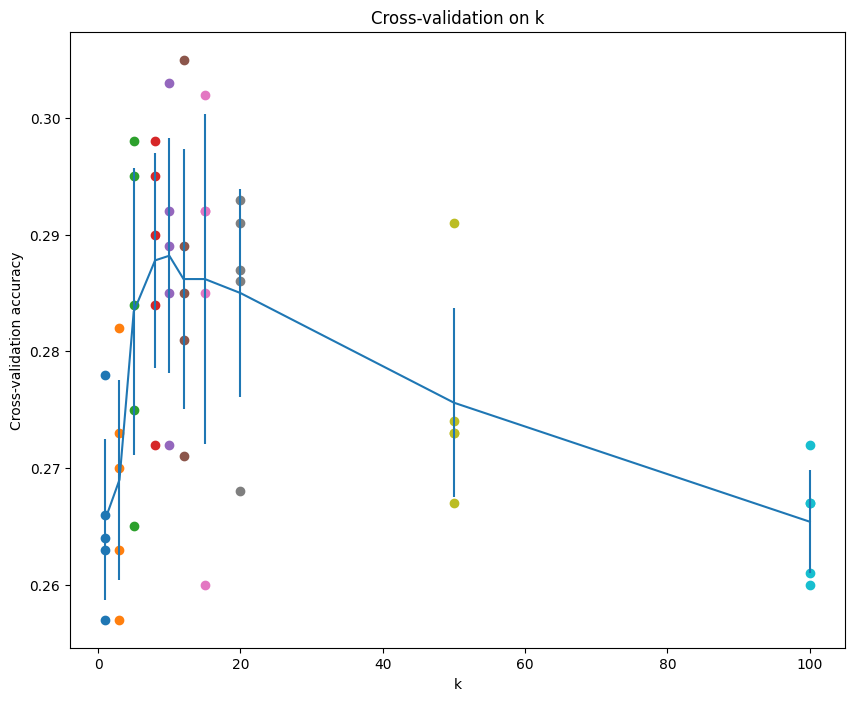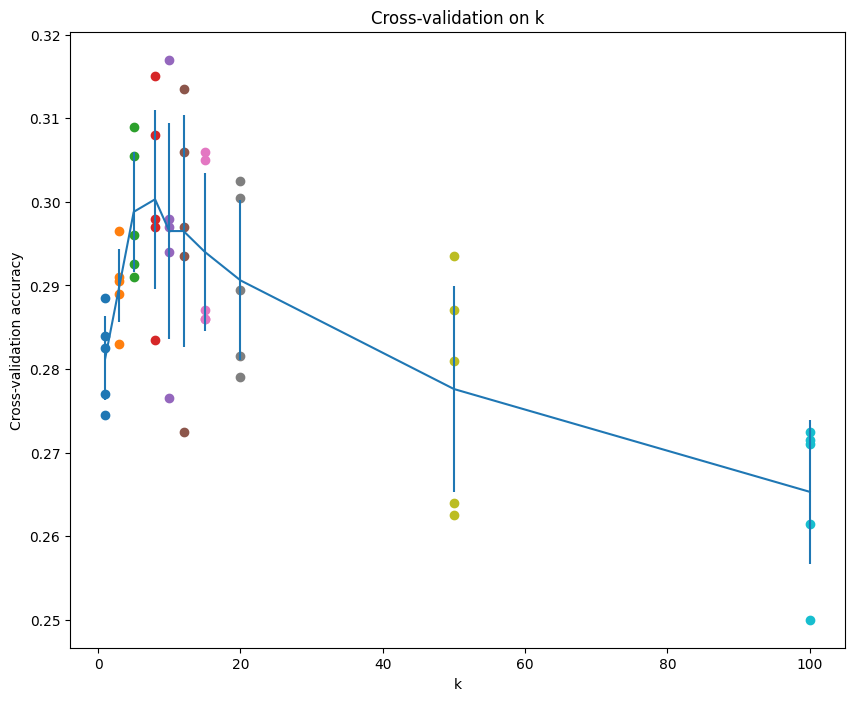KNN分类器
KNN分类器
研究生去搞AI了,最近学完了基础知识想找点项目练练手,网上看cs231评价不错就来做下他的assignment。
推荐阅读官方notebook https://cs231n.github.io/classification/
讲的很详细,读完应该就能完成assignment1中的KNN部分
整体来说还是比较简单的,可能是在学校里学过数据挖掘的原因
距离计算
一共有曼哈顿距离,欧几里得距离,切比雪夫距离三种,在KNN部分主要是使用欧几里得距离(L2 distance)
在数学里有 Lp 范数(L-p Norm)的概念,用来衡量向量的“长度”:
当 p = 1 时,就是 L1 范数(曼哈顿距离)
当 p = 2 时,就是 L2 范数(欧几里得距离)
当 p → ∞ 时,就是 L∞ 范数(切比雪夫距离)
对于L2距离的计算又有三种实现方式,具体如下:
双循环
def compute_distances_two_loops(self, X):
"""
Compute the distance between each test point in X and each training point
in self.X_train using a nested loop over both the training data and the
test data.
Inputs:
- X: A numpy array of shape (num_test, D) containing test data.
Returns:
- dists: A numpy array of shape (num_test, num_train) where dists[i, j]
is the Euclidean distance between the ith test point and the jth training
point.
"""
num_test = X.shape[0]
num_train = self.X_train.shape[0]
dists = np.zeros((num_test, num_train))
for i in range(num_test):
for j in range(num_train):
#####################################################################
# TODO: #
# Compute the l2 distance between the ith test point and the jth #
# training point, and store the result in dists[i, j]. You should #
# not use a loop over dimension, nor use np.linalg.norm(). #
#####################################################################
dists[i, j] = np.sqrt(np.sum(np.square(X[i,:] - self.X_train[j,:]),axis=0))
pass
return dists
单循环
def compute_distances_one_loop(self, X):
"""
Compute the distance between each test point in X and each training point
in self.X_train using a single loop over the test data.
Input / Output: Same as compute_distances_two_loops
"""
num_test = X.shape[0]
num_train = self.X_train.shape[0]
dists = np.zeros((num_test, num_train))
for i in range(num_test):
#######################################################################
# TODO: #
# Compute the l2 distance between the ith test point and all training #
# points, and store the result in dists[i, :]. #
# Do not use np.linalg.norm(). #
#######################################################################
dist = np.sqrt(np.sum(np.square(self.X_train - X[i,:]), axis=1))
dists[i, :] = dist
pass
return dists
无循环
def compute_distances_no_loops(self, X):
"""
Compute the distance between each test point in X and each training point
in self.X_train using no explicit loops.
Input / Output: Same as compute_distances_two_loops
"""
num_test = X.shape[0]
num_train = self.X_train.shape[0]
dists = np.zeros((num_test, num_train))
#########################################################################
# TODO: #
# Compute the l2 distance between all test points and all training #
# points without using any explicit loops, and store the result in #
# dists. #
# #
# You should implement this function using only basic array operations; #
# in particular you should not use functions from scipy, #
# nor use np.linalg.norm(). #
# #
# HINT: Try to formulate the l2 distance using matrix multiplication #
# and two broadcast sums. #
#########################################################################
test_sq = np.sum(X**2,axis=1,keepdims=True)
train_sq = np.sum(self.X_train**2,axis=1)
dists = np.sqrt(test_sq + train_sq - 2*np.dot(X, self.X_train.T))
return dists
无循环是通过数学推导得出来的,hint提示里也有说到
这样就不用进行循环,效率提升很大

KNN预测分类
得到各个向量之间的距离后就可以使用KNN算法来进行分类了
将测试数据相关的距离排序取前K个统计,票数最高的标签即为测试数据的预测结果
def predict_labels(self, dists, k=1):
"""
Given a matrix of distances between test points and training points,
predict a label for each test point.
Inputs:
- dists: A numpy array of shape (num_test, num_train) where dists[i, j]
gives the distance betwen the ith test point and the jth training point.
Returns:
- y: A numpy array of shape (num_test,) containing predicted labels for the
test data, where y[i] is the predicted label for the test point X[i].
"""
num_test = dists.shape[0]
y_pred = np.zeros(num_test)
for i in range(num_test):
# A list of length k storing the labels of the k nearest neighbors to
# the ith test point.
closest_y = []
#########################################################################
# TODO: #
# Use the distance matrix to find the k nearest neighbors of the ith #
# testing point, and use self.y_train to find the labels of these #
# neighbors. Store these labels in closest_y. #
# Hint: Look up the function numpy.argsort. 返回的是索引 #
#########################################################################
#########################################################################
# TODO: #
# Now that you have found the labels of the k nearest neighbors, you #
# need to find the most common label in the list closest_y of labels. #
# Store this label in y_pred[i]. Break ties by choosing the smaller #
# label. #
#########################################################################
closest_y = [self.y_train[j] for j in np.argsort(dists[i, :])[:k]]
label_i = Counter(closest_y).most_common(1)[0][0] # 取出几个元素 返回的是元组 [0]取第一个元组
y_pred[i] = label_i
return y_pred
至此,已经完成了作业中k_nearest_neighbor.py 需要完成的部分
交叉验证
作业的最后一部分是要要求我们设计交叉验证
介绍可见notebook中的交叉验证部分,讲的也很清楚了
Cross-validation goes a step further and iterates over the choice of which fold is the validation fold, separately from 1-5. This would be referred to as 5-fold cross-validation.
代码如下
num_folds = 5
k_choices = [1, 3, 5, 8, 10, 12, 15, 20, 50, 100]
X_train_folds = []
y_train_folds = []
################################################################################
# TODO: #
# Split up the training data into folds. After splitting, X_train_folds and #
# y_train_folds should each be lists of length num_folds, where #
# y_train_folds[i] is the label vector for the points in X_train_folds[i]. #
# Hint: Look up the numpy array_split function. #
################################################################################
X_train_folds = np.array_split(X_train,num_folds)
y_train_folds = np.array_split(y_train,num_folds)
# A dictionary holding the accuracies for different values of k that we find
# when running cross-validation. After running cross-validation,
# k_to_accuracies[k] should be a list of length num_folds giving the different
# accuracy values that we found when using that value of k.
k_to_accuracies = {}
k_to_accuracies = {k: [] for k in k_choices}
for i in range(num_folds):
X_train_cv = np.vstack(X_train_folds[:i] + X_train_folds[i+1:])
y_train_cv = np.hstack(y_train_folds[:i] + y_train_folds[i+1:])
X_val_cv = X_train_folds[i]
y_val_cv = y_train_folds[i]
classifier.train(X_train_cv,y_train_cv)
dists = classifier.compute_distances_no_loops(X_val_cv)
num_test1 = y_val_cv.shape[0]
for j in k_choices:
y_val_pred = classifier.predict_labels(dists, k=j)
num_correct = np.sum(y_val_pred == y_val_cv)
accuracy = float(num_correct) / num_test1
k_to_accuracies[j].append(accuracy)
################################################################################
# TODO: #
# Perform k-fold cross validation to find the best value of k. For each #
# possible value of k, run the k-nearest-neighbor algorithm num_folds times, #
# where in each case you use all but one of the folds as training data and the #
# last fold as a validation set. Store the accuracies for all fold and all #
# values of k in the k_to_accuracies dictionary. #
################################################################################
# Print out the computed accuracies
for k in sorted(k_to_accuracies):
for accuracy in k_to_accuracies[k]:
print('k = %d, accuracy = %f' % (k, accuracy))
最后绘制图像

但是图中显示的峰值出现是在k=10的时候,实际测试下来却是k=8时是最优的,notebook里也说k=7左右是最好的
于是我改了下数据集大小 训练集:测试集 从5000:500 换成了10000:1000 ,最后结果如下

可见峰值出现在k=10处原因是数据量太小了,扩大数据量即可
总结
做下来给我的感觉很舒服,主要是各个方面有疑问的在notebook里都有提到,提示也给的很恰当。希望后面也能保持这种质量。